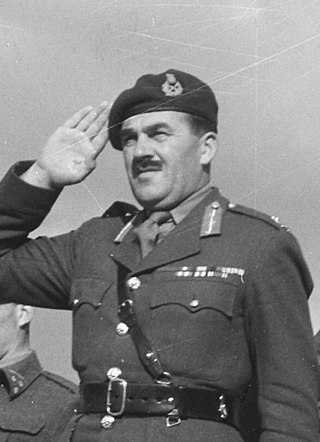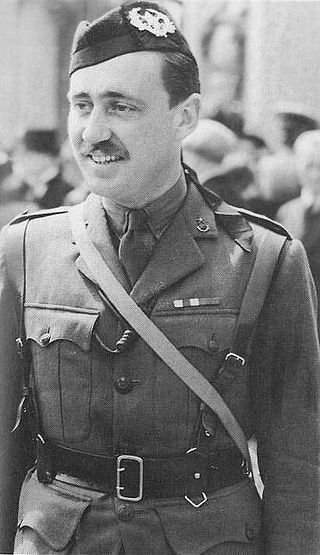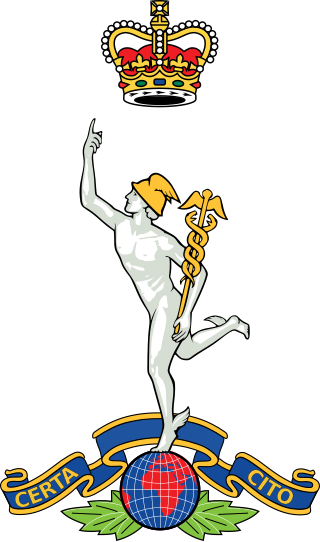
The 1st Airborne Division was an airborne infantry division of the British Army during the Second World War. The division was formed in late 1941 during the Second World War, after the British Prime Minister, Winston Churchill, demanded an airborne force, and was initially under command of Major-General Frederick A. M. "Boy" Browning. The division was one of two airborne divisions raised by the British Army during the war, with the other being the 6th Airborne Division, created in May 1943, using former units of the 1st Airborne Division.

Sir Frederick Arthur Montague Browning was a senior officer of the British Army who has been called the "father of the British airborne forces". He was also an Olympic bobsleigh competitor, and the husband of author Daphne du Maurier.

Major General Robert Elliot "Roy" Urquhart, was a British Army officer who saw service during the Second World War and Malayan Emergency. He became prominent for his role as General Officer Commanding the 1st Airborne Division, which fought with great distinction, although suffering very severe casualties, in the Battle of Arnhem during Operation Market Garden in September 1944.

The 53rd (Welsh) Infantry Division was an infantry division of the British Army that fought in both the First and Second World Wars. Originally raised in 1908 as the Welsh Division, part of the Territorial Force (TF), the division saw service in First World War, being designated 53rd (Welsh) Division in mid-1915, and fought in the Gallipoli Campaign and in the Middle East. Remaining active in the Territorial Army (TA) during the interwar period as a peacetime formation, the division again saw action in Second World War, fighting in North-western Europe from June 1944 until May 1945.

XXX Corps was a corps of the British Army during the Second World War. The corps was formed in the Western Desert in September 1941. It provided extensive service in the North African Campaign and many of its units were in action at the Second Battle of El Alamein in late 1942. It then took part in the Tunisia Campaign and formed the left flank during the Allied invasion of Sicily in 1943.

Admiral of the Fleet Bruce Austin Fraser, 1st Baron Fraser of North Cape, was a senior Royal Navy officer. He served in the First World War, saw action during the Gallipoli Campaign and took part in the internment of the German High Seas Fleet at the end of the war. He also served in the Second World War initially as Third Sea Lord and Controller of the Navy and then as second-in-command and afterwards as commander of the Home Fleet, leading the force that destroyed the German battleship Scharnhorst. He went on to be First Sea Lord and Chief of the Naval Staff in which role he assisted in establishing NATO and agreed to the principle that the Supreme Allied Commander Atlantic should be an American admiral, in the face of fierce British opposition.

Major General John Dutton Frost, was an airborne officer of the British Army, best known for being the leader of the small group of British airborne troops that actually arrived at Arnhem bridge during the Battle of Arnhem in Operation Market Garden, in the Second World War. He was one of the first to join the newly formed Parachute Regiment and served with distinction in many wartime airborne operations, such as in North Africa and Sicily and Italy, until his injury and subsequent capture at Arnhem. He retired from the army in 1968 to become a beef cattle farmer in West Sussex.

The South Wales Borderers was a line infantry regiment of the British Army in existence for 280 years.

The 10th Armoured Division was an armoured formation of division-size of the British Army, raised during the Second World War and was active from 1941–1944 and after the war from 1956–1957. It was formed from the 1st Cavalry Division, a 1st Line Yeomanry unit of the Territorial Army (TA) which had previously been serving in Palestine. The division was converted from cavalry to armour and redesignated from 1 August 1941.
Major-General Anthony John Deane-Drummond, CB, DSO, MC & Bar was an officer of the Royal Signals in the British Army, whose career was mostly spent with airborne forces.

Colonel John Llewellyn Waddy, was a British Army officer who served during the Second World War, in Palestine and during the Malayan Emergency, before becoming Colonel of the SAS.
Brigadier Thomas Haddon was a British Army officer who served with the airborne forces during the Second World War, most notably during Operation Market Garden in September 1944. Following the war he raised the Singapore Military Forces and served as Chief of Staff of Hong Kong Land Forces.

Brigadier Philip Hugh Whitby Hicks, was an officer of the British Army during both the First and Second World Wars.

Major General Douglas (Tim) Vincent, was a senior officer in the Australian Army, seeing active service during the Second World War and the Vietnam War. Graduating from the Royal Military College, Duntroon in 1938 into the Signals Corps, he volunteered for service in the Second Australian Imperial Force soon after the outbreak of the Second World War and served in Syria, Western Europe and Borneo. Later, he served as Commander Australian Force Vietnam (COMAFV) during the Vietnam War. After a number of senior staff positions he retired in 1973. He was actively involved in defence issues in his retirement and served as a chairperson of the Returned and Services League of Australia (RSL) prior to his death.
The 1st Lancashire Engineer Volunteer Corps was a Volunteer unit of Britain's Royal Engineers, first raised in 1860. It went on to spin off a unit of fortress engineers and provided a signals training centre during the First World War. Its successor units provided signal support for West Lancashire Territorial Army (TA) formations in the early stages of the Second World War, and for Eighth Army HQ during the Second Battle of El Alamein, the advance to Tunis, invasion of Sicily and through Italy, ending the war in Austria. Postwar successor units have continued in the TA and Army Reserve to the present day.
William Francis Kynaston "Sheriff" Thompson OBE was a British soldier and journalist. Born in Greenwich, London in 1909 Thompson served in the army for 30 years before becoming the defence correspondent of the Daily Telegraph.

1st Armoured Division Signals was a unit of Britain's Royal Corps of Signals providing communications for the 1st Armoured Division during the Second World War. It was present during the Battle of France, the Western Desert Campaign, including the battles of Gazala and Alamein, the Tunisian Campaign, and the Battle of Coriano during the Italian Campaign.

50 (Northumbrian) Signal Regiment was a Territorial Army (TA) unit of the British Army's Royal Corps of Signals. It had its origins in a signal company and a cyclist battalion formed in 1908 and it provided the divisional signals for the 50th (Northumbrian) Division and its duplicates during World War II. Its successors continued in the postwar TA until 2009.

The City of London Signals was a Territorial Army unit of the British Army's Royal Corps of Signals. It had its origins in a signal company of the Royal Engineers formed in 1908 and during World War II it provided the divisional signals for the 56th (London) Division and its duplicates as well as communications for the Royal Air Force in the Middle East. Its successors continued in the postwar Territorial Army and Army Reserve until 2016.

43 (Wessex) Signal Regiment was a Territorial Army (TA) unit of the British Army's Royal Corps of Signals from 1920. It had its origins in a Volunteer unit of the Royal Engineers formed in the West Country in 1860 and provided the communications for the 43rd (Wessex) Infantry Division during World War II. Its successor still serves as a squadron in today's Army Reserve.















